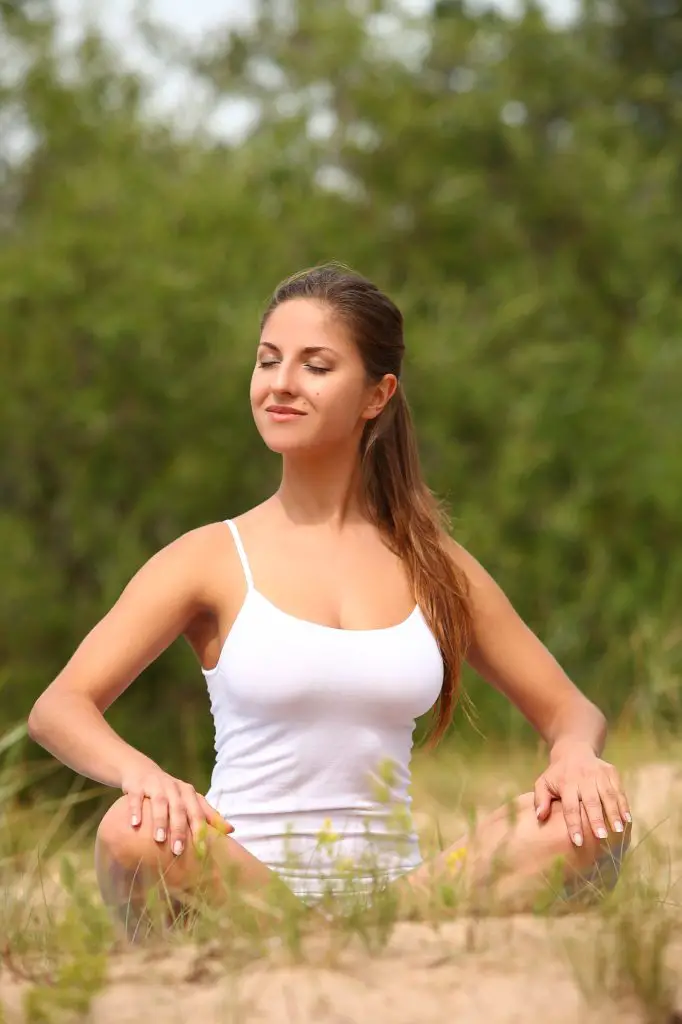A mere 10 minutes of mindfulness meditation can boost your memory. Recent studies reveal that mindfulness practices do more than just sharpen our cognitive abilities.
Medical experts now recognize their remarkable effects on both mental and physical well-being.
Research proves that mindfulness lowers blood pressure and helps control emotions better. It can even make you happier.
These practices also help us build a new relationship with our experiences. We learn to accept things with more clarity.
This post will share 7 powerful mindfulness practices that will help you handle life’s challenges with better awareness.
You’ll find practical tools that work whether you’re managing stress, trying to focus better, or working to improve your overall well-being.
Busy? Save this pin for later.
1. Mindful Breathing
Breathing sustains life, yet we rarely notice this vital process. Mindful breathing requires your complete attention to your breath’s natural rhythm. This practice asks you to observe each inhale and exhale without making changes.
You’ll notice subtle sensations you might have missed before – the slight pause between breaths, your chest’s gentle rise and fall, and the air temperature as it moves through your nostrils.
These three fundamental breathing techniques work well:
- Box Breathing: Inhale for 4 counts, hold for 4, exhale for 4, hold for 4
- 4-7-8 Breath: Inhale for 4 counts, hold for 7, exhale for 8
- Ocean Breath: Create a slight constriction in your throat while breathing
Mindful breathing’s beauty lies in its accessibility. You can practice it anywhere – during your morning commute, in waiting lines, or before important meetings. Your breath anchors you to the present moment.
I value mindful breathing’s subtle yet profound effect on our nervous system. Mindful breathing activates our parasympathetic nervous system – our body’s natural relaxation response.
This practice creates space between our thoughts and reactions, helping us respond to situations thoughtfully rather than react impulsively.
You can blend mindful breathing into your daily routine by starting with three minutes each morning.
Find a comfortable position, close your eyes, and observe your natural breath. Your mind will wander – that’s normal.
Just guide your attention back to your breathing. Soon you’ll notice better awareness of your breath, thoughts, emotions, and physical sensations.
Mindful breathing doesn’t aim to achieve a specific state or force relaxation. It helps you develop a friendly relationship with your breath and yourself.
2. Mindful Walking
Most of us walk every day, lost in thoughts about the past or future. This simple activity gives us a chance to practice presence and awareness in motion.
Mindful walking turns an everyday activity into a powerful meditation practice. It brings complete awareness to each step and creates a bridge between your mind and body. You can practice this anywhere – in a park, along city streets, or even in your home.
The core components of mindful walking include:
- Noticing the lifting and falling of each foot
- Feeling your body weight’s movement
- Being aware of your posture and arm movements
- Observing your surroundings without judgment
The sort of thing I love about mindful walking is how accessible it is. You can practice it during your daily activities, like getting the mail, walking the dog, or taking a break from your desk.
Breaking free from autopilot mode and connecting with each movement makes all the difference.
Paying such close attention to walking might feel strange at first, but this focused attention helps you reconnect with the present moment.
You’ll start noticing sensations typically overlooked – the ground’s texture beneath your feet, your steps’ rhythm, or your body’s gentle sway.
The air’s temperature on your skin, sounds in your environment, or various scents around you become noticeable.
Research shows the strong effects of this practice. Studies indicate that mindful walking can lower blood pressure, improve sleep quality, and help manage stress. People who practice it often report better wellbeing and emotional control.
Starting with just 10-15 paces in a quiet space works best. Thoughts will arise – acknowledge them without judgment and bring your attention back to walking. Safety comes first, so stay aware of your surroundings, especially in busy areas.
Mindful walking’s beauty lies in its flexibility. The pace adapts to suit your needs – from slow, thoughtful steps to a natural walking rhythm.
This practice blends mindfulness into your busy schedule while offering physical and mental benefits.
3. Mindful Eating
Food plays a central role in our lives. Many of us eat on autopilot and barely taste our meals as we rush through them.
Mindful eating brings full awareness to your eating experience. We focused on building a deeper connection with food and body signals. In fact, it lets you engage all your senses – you notice the colors, textures, aromas, flavors, and even the sounds of your food.
- Take small bites and chew slowly
- Notice the temperature and texture of each mouthful
- Put utensils down between bites
- Observe hunger and fullness signals
- Express gratitude for the meal
The sort of thing I love about mindful eating is how it goes beyond the actual meal. The practice starts with grocery shopping, moves through meal preparation, and covers the entire dining experience.
Notwithstanding that, you don’t need to spend hours on each meal – awareness of just the first three bites can make the most important difference.
Mindful eating works best when it merges into your routine gradually. You could start with one meal a day, maybe even breakfast when you’re less rushed.
The weight of your spoon, steam rising from your coffee, or the crunch of your toast deserve your attention. These small moments of awareness can turn an ordinary meal into a ritual that keeps people fed.
The practice includes acknowledging food-related thoughts and emotions without judgment. You might notice anxiety, guilt, or rushing sometimes.
Simple observation of these reactions with curiosity instead of criticism helps develop a balanced approach to eating.
Note that mindful eating isn’t about perfect practice – it brings gentle awareness to your relationship with food.
Some days will feel more present than others, and that’s fine. The goal isn’t to control eating but to boost your awareness and enjoyment of food.
4. Mindful Yoga
Yoga’s ancient practice has grown into something deeper by combining with mindfulness principles.
Mindful yoga is different from traditional yoga because it puts more weight on awareness than perfect pose alignment.
We applied Buddhist mindfulness teachings to physical practice that creates a deeper mind-body connection. This method lets you observe rather than react, making it a great way to develop self-awareness.
Research shows amazing benefits of mindful yoga. Studies prove that regular practice lowers stress hormone cortisol levels, boosts immune function, and sharpens cognitive skills.
Practitioners often show better memory, attention, and language processing. Brain imaging studies reveal that yoga practitioners have a thicker cerebral cortex and hippocampus than non-practitioners.
These elements make mindful yoga stand out:
- Body awareness and conscious movement
- Non-judgmental observation of sensations
- Integration of breath with movement
- Cultivation of present-moment awareness
Mindful yoga affects mental health substantially beyond physical benefits. Studies show it reduces depression and anxiety symptoms.
Without doubt, one of its strongest effects comes from activating the parasympathetic nervous system, which triggers natural relaxation.
The practice works better when you add other mindfulness techniques. Research shows people who did mindful yoga at least three times weekly for eight weeks had fewer depression and anxiety symptoms. These improvements lasted longer than other relaxation methods.
Mindful yoga becomes available to everyone because it adapts easily. You listen to your body instead of trying to strike perfect poses.
This means everyone can join in, whatever their physical limits. The goal stays simple – build awareness and keep a compassionate attitude toward yourself.
Your mindful yoga journey can start with gentle poses as you stay aware of your breath and body sensations.
Watch your thoughts and emotions rise without judgment. Note that the goal isn’t clearing your mind but building a more conscious connection with your experience.
Mindful yoga helps build resilience and emotional balance. Regular practice improves your stress management, sleep quality, and overall well-being. You learn to face challenges on and off the mat with greater awareness and acceptance.
5. Mindful Meditation
Buddhist practices gave birth to mindfulness meditation, which is a powerful way to boost awareness and concentration.
Mindfulness meditation teaches us to focus on the present moment without judgment. This practice is a chance to watch our thoughts, feelings, and bodily sensations come and go, similar to clouds moving across the sky.
The versatility makes this practice so powerful. Scientists are now studying how well it works for PTSD, eating disorders, and addiction. Meditation works both as prevention and therapy.
- Find a comfortable position, either lying down or seated
- Bring attention to different body parts one by one
- Notice sensations without trying to change them
- Redirect attention gently when your mind wanders
- Stay curious and non-judgmental
You don’t need to empty your mind or reach perfect calm with mindfulness meditation. Thoughts and feelings will pop up naturally as you practice. The magic happens when you watch these mental events without getting tangled in them.
Professor Jon Kabat-Zinn, who brought mindfulness into mainstream medicine, suggests practicing for 45 minutes at least six days weekly.
Research shows that even short sessions can help. To name just one example, an eight-week self-guided online mindfulness program showed a big drop in depression symptoms compared to standard treatment alone.
New practitioners should start with shorter sessions. The mind usually takes about 20 minutes to settle.
Medical schools and universities are a great way to get reliable resources if you’re just starting out, since meditation programs vary in quality.
Note that mindfulness meditation is like any other skill – it gets better with time. Think of it as exercise for your attention and awareness. Regular practice often leads to better focus, less stress, and more emotional balance in daily life.
6. Mindful Journaling
Writing helps people discover themselves and grow personally. The practice blends writing with awareness of the present moment.
Mindful journaling is different from keeping a regular diary because it focuses on accepting thoughts and emotions without judgment.
The practice gives you a safe place to explore your inner thoughts while being kind to yourself. Research shows that journaling makes you more resilient, motivated and mindful.
You can use mindful journaling in many ways. These are some powerful approaches that work well:
- Gratitude Journaling: Changes focus toward positivity
- Reflective Writing: Explores deeper emotional landscapes
- Visual Journaling: Incorporates art and creativity
- Word Dump: Releases stressful emotions
- Goal-Setting: Supports your growth path
The practice becomes more powerful when combined with meditation. Your mind becomes more receptive after a short meditation session, which leads to kinder self-awareness.
This combination improves both practices and creates a deeper connection with your thoughts and feelings.
Studies show that mindful journaling activates brain areas linked to emotions and language.
Regular practice improves working memory and heightens awareness while reducing stress and anxiety.
The practice welcomes all forms of expression – words, drawings, or simple doodles – since perfection isn’t the goal.
Mindful journaling’s effect on emotional intelligence amazes me. You might not notice how many thoughts and feelings pass through your mind until you develop this practice.
Writing helps process emotions without judgment, creating a mental “compost bin” for experiences.
The practice works best when you stay present with whatever comes up. You might notice thoughts that bother you – that’s normal. Accept each thought and feeling with kindness to create space for self-compassion and growth.
Research backs these observations. Studies indicate mindful journaling increases mindfulness, self-compassion, and emotional control. The practice also improves mental health, problem-solving abilities and emotional resilience.
Note that mindful journaling isn’t about writing perfect prose or having all the answers. Some days will flow better than others.
The real value comes from showing up regularly, being aware of your inner experience, and understanding yourself better through writing.
7. Mindful Self-Care
People often misinterpret self-care as occasional pampering or indulgence.
Mindful self-care is different from routine self-care practices because it includes present-moment awareness in every aspect of personal wellbeing. We tuned into our body’s signals and emotional needs without judgment or criticism.
The core elements of mindful self-care include:
- Creating boundaries around time and energy
- Listening to physical and emotional needs
- Practicing self-compassion daily
- Honoring personal values and limits
- Nurturing meaningful relationships
Mindful self-care goes substantially beyond simple health maintenance. You need to develop a deeper understanding of what truly nourishes you.
Sometimes this means saying no to commitments that drain your energy or setting aside time for activities that bring joy.
Mindful self-care helps you recognize and respond to stress signals early. You can address potential issues before they escalate by staying aware of subtle changes in mood, energy levels, or physical sensations. This proactive approach prevents burnout and maintains emotional balance.
Daily routines make this practice more meaningful. Morning skincare rituals and evening wind-down routines become moments of self-connection when you bring mindful attention to them. Each action gives you a chance to check in with yourself and honor your needs.
Sleep plays a vital role in mindful self-care. A conscious bedtime routine and attention to sleep quality support both physical and mental restoration. You might try gentle stretching, reading, or simply observing your breath as you prepare for rest.
There’s another reason to consider mindful movement throughout the day. You don’t need structured exercise – gentle stretching at your desk, regular walks, or simply changing positions when your body signals discomfort will do. The key is to respond to your body’s needs with awareness and kindness.
Emotional awareness is also part of mindful self-care. Greater emotional resilience develops when you acknowledge and accept your feelings without trying to change them.
This practice creates space between triggering events and your responses, which allows more conscious choices in challenging situations.
Nutrition becomes more intuitive through mindful self-care. Your body’s wisdom about hunger, fullness, and food choices becomes more trustworthy than rigid rules.
This approach encourages a healthier relationship with eating while honoring your body’s unique needs.
Note that mindful self-care isn’t about achieving perfection. Some days will be more attuned to your needs than others.
Treat yourself with the same compassion you’d offer a dear friend, and remember that self-care is an ongoing trip rather than a destination.
Final Thoughts
Mindfulness practices are a great way to get tools that change our daily experiences. Each technique – from conscious breathing to mindful self-care – builds upon the others. These techniques are the foundations of greater awareness and emotional balance.
Note that mindfulness isn’t about perfection or achieving specific results. Some days will feel more centered than others. This variation is perfectly normal.
The real impact happens when we approach these practices with curiosity and self-compassion. We need to allow each moment to be exactly as it is.
Pick one practice that appeals to you initially. You might want to take three mindful breaths before starting your day. Another option could be bringing awareness to your morning coffee ritual.
Once you feel comfortable with one technique, try exploring others gradually. Your mindfulness experience is unique. These practices will evolve with you and support your well-being in countless ways.











Leave a Reply